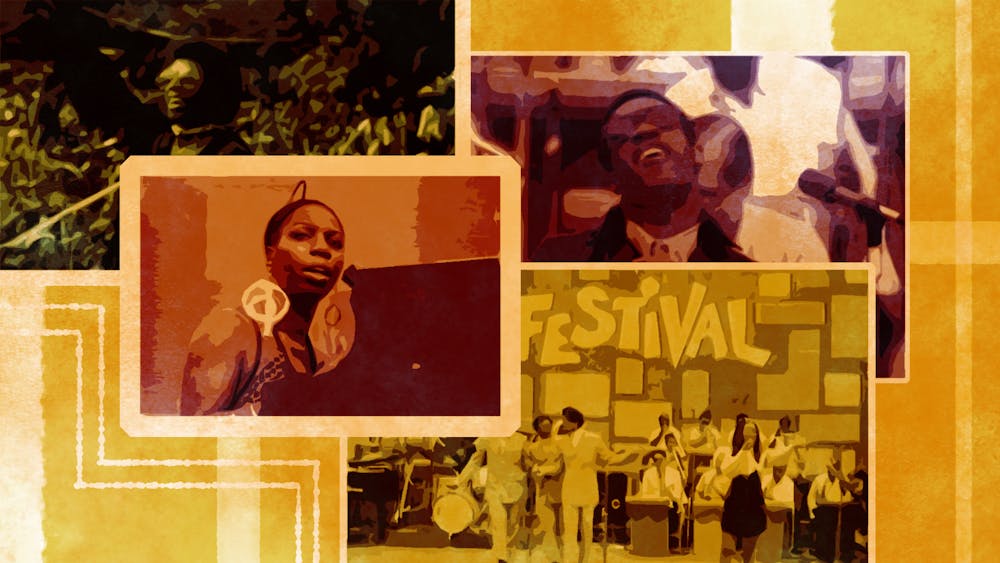Summer of Soul (...Or, When the Revolution Could Not Be Televised) opens with shots of curls, coils, kinks, and fros being glazed by the New York City summer rain. Fresh presses are covered by bright, patterned scarves. Brown hands with fire engine red nails dance in the air. A sea of dark eyes bounce from corner to corner of the stage, and a different kind of light comes from the smiles of dark faces when a 19–year–old Stevie Wonder steps on stage in a cocoa brown suit.
In Philly native Ahmir Thompson (more commonly known as Questlove)’s debut film, he perfectly weaves together previously lost live performances of the 1969 Harlem Cultural Festival and interviews of performers, public figures, and attendees. Just like the bustling streets of New York, Thompson’s work is full of color, glorious sound, and remarkable energy.
After showing a young Stevie Wonder moving unbound on stage—standing up, sitting while playing the drums, dancing, and motivating the crowd—Thompson moves to inform his viewers of the historical context of the film. Thompson lays out a few key things about being Black in the ‘60s: the importance of the Civil Rights Movement, the differences in opinions among Civil Rights leaders, the progress Black Americans had made for themselves, and just how swiftly it was all taken away. Viewers can feel the grief Black America had over the losses of Martin Luther King Jr. and Malcolm X, as well as the ambition and power held by the Black Panther Party and the Black Consciousness Movement as a whole. The combination of news clips, interviews, and music gives the audience a peek at the beating heart of Harlem in the ‘60s.
After learning about the events that led up to the festival, we see more performances of every kind. Reverend Jesse Jackson gives a sermon honoring the late Martin Luther King Jr., and Mavis Staples and Sister Mahalia Jackson sing “Precious Lord, Take My Hand” in tribute. Women scream and reach to touch David Ruffin’s hands as he performs “My Girl” as a solo artist for the very first time. Gladys Knight tells the viewers about her brief moment of stage fright seconds before one of her first performances.
Thompson also takes time to highlight the intersectionality of the Harlem Cultural Festival. We learn about the origins of the Afrocentric sense of style that blossoms later in the ‘70s.
Mongo Santamaría’s Latin pop rendition of jazz legend Herbie Hancock’s “Watermelon Man” is showcased as the connection between Cuban music and traditionally Black jazz. Santamaría’s rendition later hits No. 10 on the U.S. Billboard Hot 100 list, gets inducted into the Grammys Hall of Fame in 1998, and plays a key role in the creation of Latin Boogaloo, which is a mix of Afro–Cuban jazz and R&B. Ray Barretto's drumming connects the Latin music with Black crowd members who are familiar with the sounds and rhythms of the percussion. Barretto and Santamaría’s music gives viewers a glimpse at the Hispanic, African, Caribbean, and African American communities that make up Uptown New York City.
Thompson opens up the discussion about the effects of narcotics and poverty on the Harlem community with clips that show Redd Foxx, Willie Tyler & Lester, and Moms Mabley joking about the moon landing. But these jokes have more to them than cracks about Apollo 11; they force viewers to think about the systematic inequalities that Black people in America face. It’s not that Harlemites don't care about the Apollo because they're unpatriotic, it’s because they have objectively more important things to deal with: matters of life or death. The heroin epidemic hits the streets of Harlem hard, and instead of funding resources to help Harlem and other Black communities dealing with addiction, poverty, and crime, the United States government funds trips to the moon and an increasingly unpopular war.
The documentary begins its closing with Nina Simone banging on the keys of her piano. Simone greets cheers from the crowd in a flowing, printed yellow gown; her hair is styled to mimic that of a crown, her eyes are painted with gold and black kohl liner, and her rouged lips and cheeks are framing a wide smile. Thompson first shows us Simone performing “Backlash Blues,” which is a poem originally written by Langston Hughes that Simone makes into a song. Simone sings about the oppression and anger that people of color felt. Simone moves on to singing “To Be Young, Gifted and Black,” perfectly melding together the sounds of the excitement and sorrow felt by Black youth. Simone closes with “Are You Ready,” which is a poem that energizes Black people to take down the oppressive forces and systems that have caused them pain since the founding of this country.
Each performer tells his or her story through art, poetry, and music. The sounds and rhymes of the Harlem Cultural Festival are not only sounds of Black joy, passion, and excitement, but they are also sounds of Black pain and trauma. Summer of Soul highlights the unique voice of the Black experience in America—the sounds that give birth to genres of music and globally consumed culture. Thompson shows nearly all facets of Blackness in his documentary, giving a voice to a period of Black history that is written out of the books. Summer of Soul shows us the beauty of Harlem and the summer that the negro died and Black was born.







